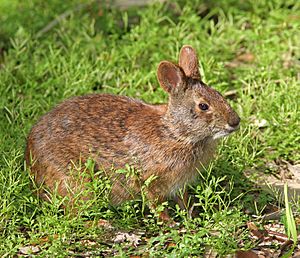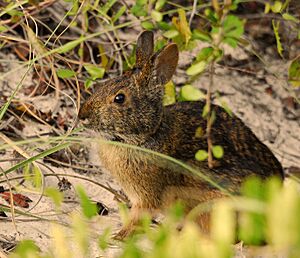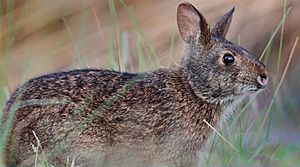Marsh rabbit facts for kids
Quick facts for kids Marsh rabbit |
|
|---|---|
 |
|
| Conservation status | |
| Scientific classification | |
| Genus: |
Sylvilagus
|
| Species: |
palustris
|
| Subspecies | |
|
S. p. palustris |
|
 |
|
| Marsh rabbit range | |
The marsh rabbit (Sylvilagus palustris) is a small cottontail rabbit that lives in wet, marshy areas and swamps. You can find them along the coasts of the Eastern and Southern United States. These rabbits are excellent swimmers and always stay close to water. They look a lot like the eastern cottontail (Sylvilagus floridanus), but marsh rabbits have smaller ears, legs, and tails.
Contents
What's in a Name?
The scientific name Sylvilagus palustris comes from Latin words. Silva means "forest," lagos means "hare," and palustris means "of the marsh." So, it basically means "forest hare of the marsh."
Marsh rabbits are sometimes confused with swamp rabbits (Sylvilagus aquaticus). However, these are two different types of rabbits. Swamp rabbits are larger and live in different areas, mainly from Alabama to Texas. Marsh rabbits have also been called marsh hares.
Rabbit Family Tree
Marsh rabbits (S. palustris) and swamp rabbits (S. aquaticus) are closely related. They share a similar genetic makeup, which shows they came from a common ancestor. Scientists have studied their genes and found that these two rabbit species are like "sister" species within their group.
How Big Are They?
Marsh rabbits are usually smaller than eastern cottontail rabbits. Adult marsh rabbits living in the Florida peninsula weigh about 1 to 1.2 kilograms (2.2 to 2.6 pounds). They can be up to 43 centimeters (17 inches) long.
Rabbits from mainland areas are often bigger. They can weigh up to 1.6 kilograms (3.5 pounds) and grow to more than 44.5 centimeters (17.5 inches) long. Their back feet are also a bit larger.
Different Types of Marsh Rabbits
There are three known types, or subspecies, of marsh rabbits:
- Carolina marsh rabbit (Sylvilagus palustris palustris): This is the marsh rabbit found in mainland areas.
- Florida marsh rabbit (Sylvilagus palustris paludicola): This smaller rabbit lives only in the Florida peninsula.
- Lower Keys marsh rabbit (Sylvilagus palustris hefneri): This type is found only in the southern Florida Keys. It is considered an endangered species, meaning it's at risk of disappearing forever.
What Do They Look Like?
Marsh rabbits have fur that is blackish-brown or dark reddish on their backs. Their bellies are usually a dull brownish-gray, but some mainland rabbits might have a dull white belly. The edges of their ears have small black tufts.
Their fur color can change with the seasons. In spring and summer, the black parts might turn a dull grayish-buff. In fall, they become reddish or ochre, and in winter, they get darker black again. Marsh rabbits in Florida tend to be darker and redder, with cinnamon-red fur on their necks, feet, and legs. Young rabbits are usually darker and duller in color than adults.
One way to tell marsh rabbits apart from swamp rabbits and cottontails is their tail. The underside of a marsh rabbit's tail is almost never white; it's usually brownish-gray. Some marsh rabbits in southern Florida are completely black. This is called melanism, and their color doesn't change with the seasons.
Marsh rabbits also have shorter ears and legs compared to swamp rabbits. Their tails are much smaller than the bushy tails of cottontails.
Where Do They Live?
The Carolina marsh rabbit (S. p. palustris) lives along the eastern coast from Virginia down to northern Florida. It also lives along the Gulf Coast to Mobile Bay, Alabama. These rabbits stay in coastal lowlands, swamps, and near rivers. They are rarely found more than 64 kilometers (40 miles) from the coast.
The Florida marsh rabbit (S. p. paludicola) lives in the Florida peninsula, from south of the Florida Panhandle to the upper Keys. There's a small area north of Miami where this type isn't found. The endangered Lower Keys marsh rabbit (S. p. hefneri) lives only in the southern Florida Keys.
Their Home
Marsh rabbits usually live in marshes with salty or fresh water, especially those with cattails and cypress trees. In southern Florida, they often live on sandy islands and in mangrove swamps. They always need easy access to water, which is different from most other rabbits.
They might go into tidal marshes but stay close to higher ground for safety. They often hide in thick bushes of magnolia, black-gum, sweet-gum, briers, and cattails.
Reproduction and Life Cycle
Marsh rabbits can have babies all year long. A mother rabbit usually has 2 to 4 young at a time. The babies grow inside her for about 30 to 37 days. Adult females can have up to 6 litters (groups of babies) each year. This means they can produce about 15 to 20 young annually.
Nests are made from rushes, grasses, and leaves. The mother lines the well-hidden nest with her own fur. Nests are often found in thick bushes or swampy places that are completely surrounded by water for protection.
What Do They Eat?
Marsh rabbits are herbivores, meaning they only eat plants. They mainly eat the leaves and bulbs of marsh plants like cattails, brushes, and grasses. They also enjoy other water or marsh plants such as centella, greenbrier vine, marsh pennywort, water hyacinth, wild potato, and amaryllis.
Like all rabbits, marsh rabbits eat their food twice. This is called coprophagy. Rabbits produce two types of droppings: hard ones and soft ones. They quickly eat the soft droppings, called cecal pellets, to digest them again. This helps them get more nutrients from the plants they eat. Since rabbits don't have a special stomach like cows, this process helps them get the most out of their food.
Behavior
Marsh rabbits are most active at night. During the day, they usually rest in hidden spots. They often hide in thick bushes, hollow logs, or tall grasses and cattails. They might also use burrows (holes in the ground) that other animals have left behind.
These rabbits often create paths, called "runways," through thick plants along the edges of marshes. You can easily spot these paths because the rabbits mark them with their droppings.
A unique thing about marsh rabbits is how they walk. They often walk on all four feet, placing each foot down one after another, like a cat. While they can hop like other rabbits, this walking style helps them move better through dense plants. Their steps are usually short, about 8.9 to 16.5 centimeters (3.5 to 6.5 inches) long. Their footprints are also special because their toes are spread wide apart.
Marsh rabbits love water even more than swamp rabbits. They are not found in forests. They go into the water easily and are excellent swimmers. To help them swim, their back legs have less fur and longer nails than typical cottontails. When they are not hiding in thick bushes, they might stay underwater with only their eyes and noses showing, and their ears laid flat back. If they are spotted, they will quickly swim to a new hiding place or floating plants.
Because marsh rabbits have very short back legs, they usually escape predators by quickly turning and doubling back. This can sometimes make them easy for dogs to catch. When they are forced out of their hiding spots, they might make a squealing sound as they run away.
Large birds like the great horned owl and northern harrier (also called marsh hawk) are major predators of marsh rabbits. Other animals that hunt them include alligators, snakes, bobcats, foxes, and coyotes.
Humans and Marsh Rabbits
In some parts of the Southern United States, people hunt marsh rabbits. Sometimes, they burn large areas of dry grass to make the rabbits run out. In certain states, the marsh rabbit is considered a game animal, and hunting is managed by the Department of Natural Resources. For example, in South Carolina, there's a hunting season from November 27 to March 2, and hunters can catch up to 5 rabbits per day.
Marsh rabbits mainly eat water plants, so they usually don't cause much trouble for most farm crops. However, in southern Florida, they are considered a problem for sugar cane fields because they eat the plants.
See also
 In Spanish: Conejo de los pantanos para niños
In Spanish: Conejo de los pantanos para niños





